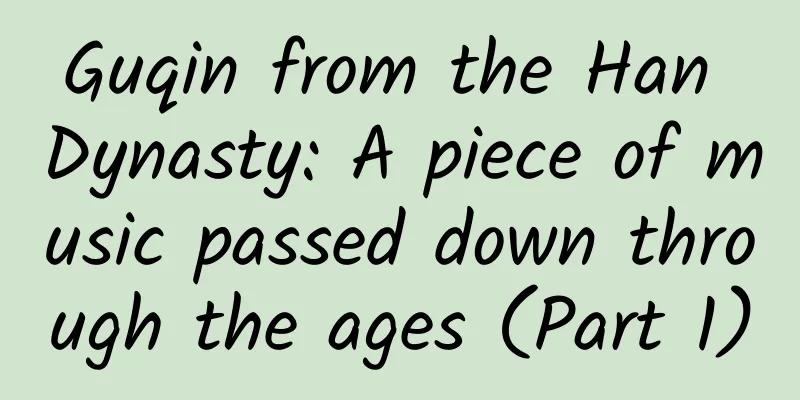Guqin from the Han Dynasty: A piece of music passed down through the ages (Part 1)

|
Guqin from the Han Dynasty: A piece of music passed down through the ages (Part 1) Scholars of Lü Zhi Culture Before the Han Dynasty, Confucius advocated the Shao music, which was perfect and could make him "not know the taste of meat for three months", which was basically within the scope of the ritual music norms of the Zhou Dynasty. Laozi and Zhuangzi, who were about the same time, began to pay attention to the essence of music and proposed the aesthetic pursuit of emptiness and tranquility, but their influence on the development of guqin music was not gradually evident until the guqin became literati-oriented in the Han Dynasty. [Tang Dynasty] Yan Liben, "Portraits of Confucius' Disciples", Capital Museum Collection The Formation of Guqin Culture in the Han Dynasty Guqin is often referred to as "literati's qin". Guqin culture is actually "literati's qin". The so-called "literati's qin" refers to the process in which Guqin is widely recognized by literati as a symbolic instrument. "Literati" here refers to all people who are knowledgeable, polite and literary, including "scholars" and "gentlemen" in ancient times. Since the beginning of records, Guqin has been valued by literati, such as Boya and Ziqi in ancient times. At that time, literati played the qin mostly to express their emotions and aspirations. In the context of the Zhou Dynasty's ritual and music system, the guqin's more important function was to serve as an instrument for elegant music. This situation did not change until the Han Dynasty, when the guqin evolved from an instrument for elegant music to an image of elegant music. The instrument emphasizes its form, while the image emphasizes its spirit. The former emphasizes the guqin's ritual and music functions, while the latter emphasizes its cultural spirit and aesthetic imagery. And the literati played a key role in this evolution. [Han Dynasty] "Duke Zhou assists King Cheng" stone rubbings, Yulin Han Dynasty Stone Relief Museum After the wars at the end of the Qin Dynasty, the Han Dynasty finally unified the country. The rulers followed the example of the ancients and wanted to revive rituals and music. However, according to Ban Gu's "Book of Han·Rituals and Music": After the founding of the Han Dynasty, there was a musician named Zhi. Their families served as high-ranking music officials for generations because of the rhythm and sound of classical music. However, they could only record the sounds of drums and gongs, but could not explain their meaning. For the Han people, the ancient court music was only the "clanging of guns and drums", but they did not know the meaning. On the other hand, the Han people may have lost interest in the classical court music. However, due to the need of "suburban sacrifice rituals", the Han Dynasty still needed to create court music. Any dynasty's reference to the culture of the previous dynasty will have "losses and gains". Emperor Wu of Han restored the "rites of suburban sacrifices", but did not completely imitate the rituals and music of the Zhou Dynasty, which was a "loss"; he established the Music Bureau, collected ballads, and created new sounds, and was innovative to highlight his status as the master of the world, which was a "gain". Objectively speaking, the rituals and music at that time showed the country's strength and prosperity, which can be said to be the characteristics of the Han Dynasty's revival of rituals and music. And it is this characteristic that provided historical conditions for the maturity of Guqin culture. [Eastern Han Dynasty] Music and Dance Picture Stone Rubbings, Collection of Yinan Han Tomb Museum Guqin has long been inseparable from literature due to its elegant taste and high status, and has even become a symbol of the life of literati. Its musicality has taken a back seat, and the way of guqin has become a special ideological system, which is a concentrated embodiment of the concept of "harmony" of ancient Chinese literati. Among the new music of the Han Dynasty, the guqin did not play a prominent role. It even seemed out of place in the Han music that was popular with "clang, drum and drum". According to the literature, the music with grand momentum and heroic style at that time was mainly drum and wind music. For example, the scale of the band during the reign of Emperor Cheng was recorded in the "Book of Han: Rites and Music", which mainly included drummers and wind and drummers. Among the existing Han Dynasty pottery figurines, there are a large number of drum and horn figurines, which shows the important position of drum and horn music in Han music. There are deep-seated reasons why literati paid attention to the guqin under such unfavorable conditions and even regarded it as the representative instrument for restoring ancient elegant music. [Eastern Han Dynasty] Figurine of a person playing a flute 1, unearthed in the northeastern suburb of Luoyang in 1992 [Eastern Han Dynasty] Blowing figurine 2, unearthed in the northeastern suburb of Luoyang in 1992 [Eastern Han Dynasty] Blowing figurine 3, unearthed in Beiyao Township, Yanshi, Luoyang in 1997 [Eastern Han Dynasty] A figurine of a person playing the flute, unearthed in Beiyao Township, Yanshi, Luoyang in 1997 [Eastern Han Dynasty] A figurine of a person playing the Xun, unearthed in Beiyao Township, Yanshi, Luoyang in 1997 The ambitious Emperor Wu of Han changed the ritual and music tradition. The so-called "suburban sacrifice music" was a new sound that incorporated the Zheng sound. This was unacceptable to the literati who had read the books of sages. Especially during the reign of Emperor Wu, Confucianism flourished, and an important part of Confucianism was to trace back to the Zhou rituals. The new sound was not acceptable. For example, Hou Jin of the Eastern Han Dynasty lamented in "Zheng Fu": After the elegant music ended, Zheng and Wei continued to revise it, with new tunes changing and graceful playing. Ruan Yu, who lived in the late Eastern Han Dynasty, also expressed a similar sentiment: The wonder of the zither...the new sound that prolongs life, how can it be compared to this. It can be seen that the literati of the Han Dynasty held an exclusionary attitude towards musical instruments such as the guzheng, believing that they could not be compared with the guqin. More importantly, these scholars repeatedly made suggestions to the rulers about establishing rituals and music, but none of them were adopted. For example, Jia Yi believed that the Han Dynasty inherited the Qin system, which was "abandoning rituals and morality" and "corrupting customs", and suggested that Emperor Wen "should establish a system and promote rituals and music, so that the princes can be in line, the people can be simple, and the lawsuits can be reduced." In the end, "the ministers such as Jiang Guan were against it, so the proposal was shelved." Dong Zhongshu persuaded Emperor Wu with rituals and music: Therefore, since the Han Dynasty gained control of the country, it has always wanted to govern well, but it has not been able to overcome cruelty and killing. The reason for this is that it should have changed but failed to do so. It is better to retreat and change; change will lead to good governance. However, Emperor Wu was busy "conquering the four barbarians and was keen on military achievements, so he had no time to pay attention to matters of etiquette and culture." The suggestions of Wang Ji during the reign of Emperor Xuan and Liu Xiang during the reign of Emperor Cheng were also ignored. From this we can see that although the new rituals and music of the Han Dynasty showed the magnificent atmosphere of the new dynasty, the literati in the court who "believed in and loved the ancients" were sad and lamented the decline of rituals and music, so much so that Ban Gu also sighed: Today, the Great Han has succeeded the Zhou, but it has long been without grand ceremonies and has not yet established rituals and music. This is what made Jia Yi, Zhongshu, Wang Ji, Liu Xiang and their ilk angry and lament. The literati were frustrated in such a social environment, and their decline deepened their dissatisfaction with the rituals and music of the time, which in turn aroused the desire to restore the ancient ritual and music system. Throughout history, scholars were good at playing the guqin, and they all "made sounds and expressed their feelings with the guqin and qin". The guqin was indispensable for scholars to express their feelings and aspirations, especially for scholars who were frustrated. In the Han Dynasty, when new sounds emerged and the guqin gradually faded out of court music, the appreciation and aesthetics of the guqin by scholars probably also underwent a qualitative change, so that many images of the guqin appeared in bronze mirrors, tombs and other decorations at that time. [Western Han Dynasty] Portrait mirror, unearthed from the tomb of Liu Yi, Marquis of Wanqu in the Western Han Dynasty, at Boji Mountain, Xuzhou, Xuzhou Museum Line drawing of portrait Portrait mirror part [Eastern Han Dynasty] Mirror with the image of the Queen Mother of the West dancing, unearthed in Shaoxing, collected by Zhejiang Provincial Museum [Eastern Han Dynasty] Tombstone of Xu Aqu, unearthed in Lixianggongzhuang, Nanyang City in 1973, collection of Nanyang Han Painting Museum Guqin gradually lost its utilitarian status as a musical instrument in the Western Han Dynasty, especially after Emperor Wu. This somewhat changed the psychology of scholars, and forced them to re-examine the value of Guqin. In the minds of Han Dynasty scholars, due to psychological needs, the utilitarian nature of Guqin as a symbol of classical music was still strengthened, but at the same time, due to changes in aesthetic psychology, the non-utilitarian feeling of Guqin triggered their "aesthetic perception", which led to some symbolic associations. When the utilitarian nature of Guqin gradually degenerated, the association with its image became more prominent. These symbolic associations are based on the characteristics of the guqin itself, which is the internal reason why the guqin became more literati-oriented in the Han Dynasty. It has three characteristics, as follows: Piano Sound As mentioned above, elegant music is the music of "moderation and peace", which is also the standard pursued by Han Dynasty literati who always regarded the guqin as an instrument of elegant music. Sima Qian said in "Records of the Grand Historian": All correct teachings begin with music, and correct music leads to correct conduct. Therefore, music is used to stir the blood, circulate the spirit, and harmonize the mind... The length of the zither is eight feet and one inch, which is the correct measure. In ancient times, the five notes of gong, shang, jue, zhi and yu were used as the correct tunes for the guqin. The so-called "clear sound and five notes rising" is the experience of the literati in the Han Dynasty. The "five notes rising" here can be understood as the musical function of "correct sound and correct behavior" mentioned by Sima Qian. It can be seen that the sound of the guqin can give the literati in the Han Dynasty a sense of elegance and correctness of classical music, so the guqin was used as the instrument for classical music. What's more, "Book of Rites·Book of Music" says: When a gentleman listens to music, he does not just listen to the clanging of sounds, he also seeks to relate to something else. This shows that the literati valued the connotation of music "the harmony of heaven and earth" rather than its external form of expression, and they disdained the new sounds of the Han Dynasty such as "clanging guns and drums". [Han Dynasty] Carriage and Horse Welcoming Guests Stone Portrait Collection of Xuzhou Han Portrait Research Association Musical Instruments In addition to the fact that the sound of the guqin conforms to the elegant and upright ideological pursuit of the Han Dynasty literati, the shape of the guqin also meets the aesthetic pursuit of "image thinking" of the Han Dynasty literati. In the "New Theory of the Qin Dao" by Huan Tan of the Eastern Han Dynasty, there is such a record: In the past, Shennong succeeded Fuxi as the ruler of the world. He looked to the sky for guidance, the earth for guidance, his own body for guidance, and objects far away for guidance. He then carved paulownia into a zither and used silk as strings to communicate with the gods and harmonize heaven and earth. The paulownia zither is three feet six inches and six tenths of an inch thick, which represents the number of tassels; it is eight inches thick, which represents the number of thirty-six; and it is six tenths wide, which represents the six musical notes. It is round and narrow at the top, which represents the sky; it is flat at the bottom, which represents the earth... The zither has seven strings, which are enough to communicate with all things and to examine the order of things. The Zhou Dynasty's ritual and music thought of "great music is in harmony with heaven and earth" was reflected in the guqin in the Han Dynasty. Han Dynasty literati also associated the shape of the guqin with the ancient people's thought of "the sky is round and the earth is square", in order to meet their ideological demands of "harmony between heaven and earth", "connecting all things", and "examining and governing chaos" on the guqin. It can be seen that the guqin can be regarded as a representative of "great music" in the minds of Han Dynasty literati, which is one of the reasons why the image of the guqin was very popular at that time. In the late Eastern Han Dynasty, Cai Yong's "Qin Cao" basically inherited this idea and even included astronomy and geography in the guqin. [Eastern Han Dynasty] Stone coffin with banquet and acrobatics, unearthed in Xinsheng, Pi County, Sichuan Province in 1972, now in the collection of Sichuan Museum A sarcophagus rubbing of a banquet and acrobatics Part of the stone coffin with a picture of banquet and acrobatics Partial rubbing of a stone coffin with a picture of banquet and acrobatics Qinde Most of the scholars in the Han Dynasty were based on Confucianism, and Confucius' gentlemanly virtue became their ideal. Therefore, the aesthetic objects used by scholars to compare virtues must have their own characteristics that meet the aesthetic standards pursued by scholars. In the Han Dynasty, an obvious example is that scholars often sang about the guqin with "elegance" and "virtue". Liu Xiang's "Ode to the Elegant Qin" says: The wanderer’s mind is to have broad horizons, and to be filled with virtue and joy... and to follow the example of noble conduct. Fu Yi's Qin Fu says: Gaiyaqin's Li Pu... Ma Rong's Qin Fu says: In the past, when Shi Kuang played the instrument three times, divine beings descended and two black cranes danced in the courtyard. How profound is the virtue of the zither! Cai Yong's "Fu on Playing the Qin" says: Judging from the poets, the zither and the harp are suitable, so elegant instruments were made to harmonize with the tunes of bells. Huan Tan concluded in his New Theory on the Way of Qin: The eight tones are broad and the virtue of the zither is the best. The fu written by literati were expressions of emotions with a strong subjective color, but Huan Tan's "New Theory: The Way of the Qin" was a rational summary. Therefore, both emotionally and rationally, the literati affirmed the "comparative" function of the guqin. [Eastern Han Dynasty] Terracotta Warriors Playing Qin, Sichuan Museum Collection [Eastern Han Dynasty] Qin-playing figurine, Shanghai Museum [Eastern Han Dynasty] Qin-playing figurine, from the Guimet Museum of Asian Art, France It is not difficult to see that under the historical background of the time and the changes in the aesthetic psychology of the literati, the guqin and the Han Dynasty literati had internal and external points of convergence, which led to the maturity of the guqin culture in the Han Dynasty. From the perspective of the historical development process, such a close relationship can be said to have its origins and is an inevitable relationship. |
<<: How come birds are also playing the "fourth love"?
>>: Is the fetus a parasite of the mother? Let's make this clear today
Recommend
[Apple changes the rules again] AppStore/Featured Recommendations: What does the sudden revision mean to developers?
Those who like to pay attention to the mobile App...
Do you often feel pain here and there? Don’t just endure chronic pain anymore. Here are 5 ways to relieve it.
Pain is a warning signal from the body Just like ...
Hyundai recalls 80,000 electric vehicles, battery supplier LG bears 70% of the cost, good news for CATL
Electric vehicle spontaneous combustion is a big ...
It’s so cold, how to dress scientifically when it’s getting warmer and colder!
Loading long image... Source: Chongqing Science a...
What are the functions of developing a mini program for outdoor products? How much does it cost to develop a mini program for outdoor sports?
With the widespread promotion of short videos, out...
Why is the sense of participation in QQ getting worse and worse compared to WeChat?
When it comes to participation, perhaps everyone ...
Behind the 260 million yuan fine: How did Qvod become a rogue platform?
It seems impossible for Qvod to be reborn. It was...
Do you have promotional abilities?
There are many tasks that operations are responsi...
China Automobile Dealers Association: China's used car manager index was 43.8% in December 2021
On January 6, 2022, the China Automobile Dealers ...
Hejun "Zeng Qiao's Capital Observation" Season 5
Supported by a 30-person research team, each sess...
Why do Emoji look different on different platforms?
Why does the same smiling emoji look so different...
Planning and promotion: an advanced guide to planning! (recommended collection)
Most planners have heard of theories such as USP,...
How can a novice quickly build an information flow account? Teach you how to do it in 3 steps!
Many optimizers who have just started to work on ...
Can roads also charge cars? Photovoltaic roads allow "driving + charging" at the same time
□ Right to speak Recently, the Tarim Oilfield Pho...
Detailed explanation of iOS APP architecture design
iOS APP Architecture Design 1. Overview of APP Ar...









